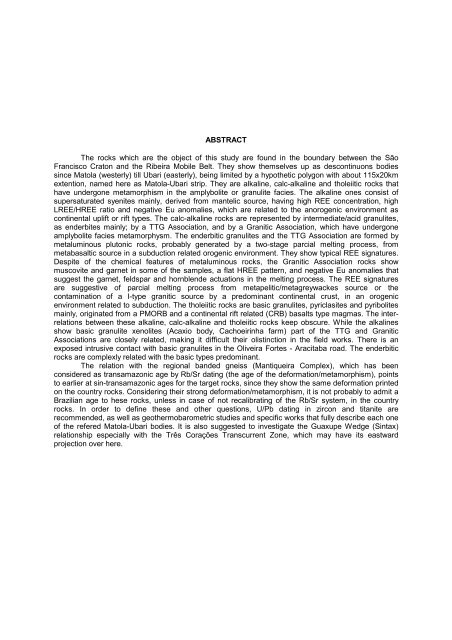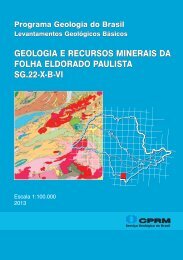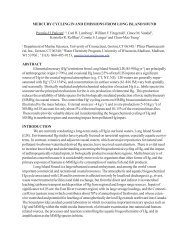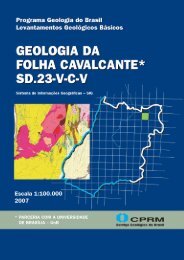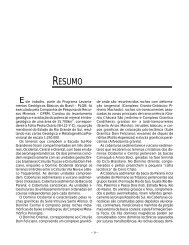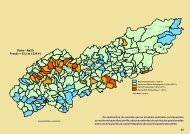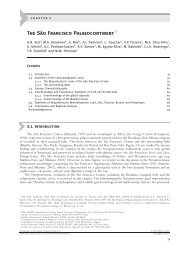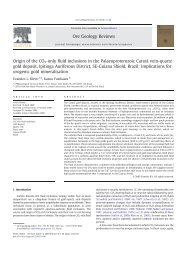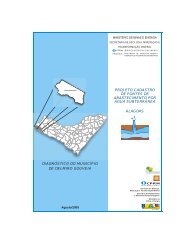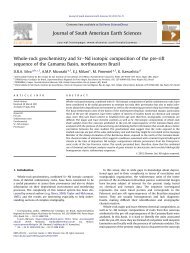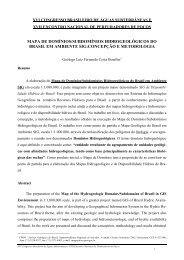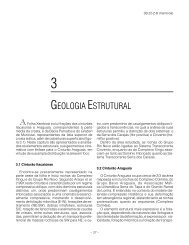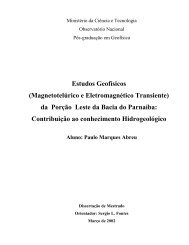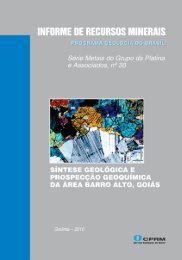Petrologia de rochas alcalinas, cálcio-alcalinas e toleíticas ... - CPRM
Petrologia de rochas alcalinas, cálcio-alcalinas e toleíticas ... - CPRM
Petrologia de rochas alcalinas, cálcio-alcalinas e toleíticas ... - CPRM
Create successful ePaper yourself
Turn your PDF publications into a flip-book with our unique Google optimized e-Paper software.
ABSTRACT<br />
The rocks which are the object of this study are found in the boundary between the São<br />
Francisco Craton and the Ribeira Mobile Belt. They show themselves up as <strong>de</strong>scontinuons bodies<br />
since Matola (westerly) till Ubari (easterly), being limited by a hypothetic polygon with about 115x20km<br />
extention, named here as Matola-Ubari strip. They are alkaline, calc-alkaline and tholeiitic rocks that<br />
have un<strong>de</strong>rgone metamorphism in the amplybolite or granulite facies. The alkaline ones consist of<br />
supersaturated syenites mainly, <strong>de</strong>rived from mantelic source, having high REE concentration, high<br />
LREE/HREE ratio and negative Eu anomalies, which are related to the anorogenic environment as<br />
continental uplift or rift types. The calc-alkaline rocks are represented by intermediate/acid granulites,<br />
as en<strong>de</strong>rbites mainly; by a TTG Association, and by a Granitic Association, which have un<strong>de</strong>rgone<br />
amplybolite facies metamorphysm. The en<strong>de</strong>rbitic granulites and the TTG Association are formed by<br />
metaluminous plutonic rocks, probably generated by a two-stage parcial melting process, from<br />
metabasaltic source in a subduction related orogenic environment. They show typical REE signatures.<br />
Despite of the chemical features of metaluminous rocks, the Granitic Association rocks show<br />
muscovite and garnet in some of the samples, a flat HREE pattern, and negative Eu anomalies that<br />
suggest the garnet, feldspar and hornblen<strong>de</strong> actuations in the melting process. The REE signatures<br />
are suggestive of parcial melting process from metapelitic/metagreywackes source or the<br />
contamination of a I-type granitic source by a predominant continental crust, in an orogenic<br />
environment related to subduction. The tholeiitic rocks are basic granulites, pyriclasites and pyribolites<br />
mainly, originated from a PMORB and a continental rift related (CRB) basalts type magmas. The interrelations<br />
between these alkaline, calc-alkaline and tholeiitic rocks keep obscure. While the alkalines<br />
show basic granulite xenolites (Acaxio body, Cachoeirinha farm) part of the TTG and Granitic<br />
Associations are closely related, making it difficult their olistinction in the field works. There is an<br />
exposed intrusive contact with basic granulites in the Oliveira Fortes - Aracitaba road. The en<strong>de</strong>rbitic<br />
rocks are complexly related with the basic types predominant.<br />
The relation with the regional ban<strong>de</strong>d gneiss (Mantiqueira Complex), which has been<br />
consi<strong>de</strong>red as transamazonic age by Rb/Sr dating (the age of the <strong>de</strong>formation/metamorphism), points<br />
to earlier at sin-transamazonic ages for the target rocks, since they show the same <strong>de</strong>formation printed<br />
on the country rocks. Consi<strong>de</strong>ring their strong <strong>de</strong>formation/metamorphism, it is not probably to admit a<br />
Brazilian age to hese rocks, unless in case of not recalibrating of the Rb/Sr system, in the country<br />
rocks. In or<strong>de</strong>r to <strong>de</strong>fine these and other questions, U/Pb dating in zircon and titanite are<br />
recommen<strong>de</strong>d, as well as geothermobarometric studies and specific works that fully <strong>de</strong>scribe each one<br />
of the refered Matola-Ubari bodies. It is also suggested to investigate the Guaxupe Wedge (Sintax)<br />
relationship especially with the Três Corações Transcurrent Zone, which may have its eastward<br />
projection over here.


